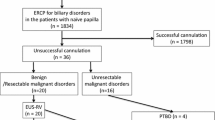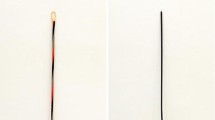Abstract
Significant pain can occur after removing transhepatic catheters from biliary access tracks, after percutaneous biliary drainage (PBD) or stenting. We undertook a randomized prospective study to ascertain whether track embolization decreases the amount of pain or analgesic requirement after PBD. Fifty consecutive patients (M:F, 22:28; age range:29–85 years; mean age: 66.3 years) undergoing PBD were randomized to receive track embolization or no track embolization after removal of biliary drainage catheters. A combination of Lipoidol and n-butyl cyanoacrylate were used to embolize transhepatic tracks using an 8F dilator. The patients who did not have track embolization performed had biliary drainage catheters removed over a guide wire. A visual analog scoring (VAS) system was used to grade pain associated with catheter removal, 24 h afterward. A required analgesic score (RAS) was devised to tabulate the analgesia required. No analgesia had a score of 0, oral or rectal nonopiate analgesics had a score of 1, oral opiates had a score of 2, and parenteral opiates had a score of 3. The average VAS and RAS for both groups were calculated and compared.
Seven patients were excluded for various reasons, leaving 43 patients in the study group. Twenty-one patients comprised the embolization group and 22 patients comprised the nonembolization group. The mean biliary catheter dwell time was not significantly different (p > 0.05) between the embolization group and nonembolization (mean: 5.4 days vs 6.9 days, respectively). In the nonembolization group, the mean VAS was 3.4. Eight patients required parenteral opiates, three patients required oral opiates, and five patients required oral or rectal analgesics, yielding a mean RAS of 1.6. In the embolization group, the mean VAS was 0.9. No patient required parenteral opiates, six patients required oral opiates, and two patients had oral analgesia. The average RAS was 0.6. Both the VAS and the RAS were significantly lower in the embolization group compared with the nonembolization group (p < 0.0023 and p < 0.002, respectively). No complications were seen related to track embolization. Percutaneous track embolization after removal of biliary drainage catheters decreases patient’s perception of pain and decreases the amount of required analgesia. In particular, the amount of opiate analgesia required is considerably less.



Similar content being viewed by others
References
van der Velden JJ, Berger MY, Bonjer HJ, et al. (2000) Percutaneous treatment of bile duct stones in patients treated unsuccessfully with endoscopic retrograde procedures. Gasttointest Endosc 51 (4 Pt 1):418–422
Nelsen KM, Kastan DJ, Shetty PC, et al. (1996) Utilization pattern and efficacy of nonsurgical techniques to establish drainage for high biliary obstruction. J Vasc Interv Radiol 7(5):751–756
Guenther RW, Schild H, Thelen M (1998) Percutaneous transhepatic biliary drainage: experience with 311 procedures. Cardiovasc Intervent Radiol 11:65–71
Winick AB, Waybill PN, Venbrux AC (2001) Complications of percutaneous transhepatic biliary interventions. Tech Vasc Intervent Radiol 4(3):200–206
Rege RV (1995) Adverse effects of biliary obstruction: implications for treatment of patients with obstructive jaundice. Am J Roentgenol 164(2):287–293
Mueller PR, Biswal S, Halpern EF, et al. (2000) Interventional radiologic procedures: Patient anxiety, perception of pain, understanding of procedure, and satisfaction with niedicationaprospective study. Radiology 215(3):684–688
Savader SJ, Trerotola SO, Merine DS, et al. (1992) Hemobilia after percutaneous transhepatic biliary drainage: Treatment with transcatheter embolotherapy. J Vasc Intervent Radiol 3:345–352
Nakagawa N, Nakajima Y, Bird SM, et al. (1994) Immediate transbiliary embolization of a biliary–hepatic artery fistula during access for percutaneous biliary drainage. Cardiovasc Intervent Radiol 17(5):295–297
Schmitz-Rode T, Blaum M, Hubner D, et al. (2000) Catheter tract embolization after percutaneous transhepaic biliary intervention. RoFo Fortschr Geb Rontgenstr Neuen Bildgeb Verfahr 172(2):179–183
Chisholm RA, Jones SN, Lees WR (1989) Fibrin sealant as a plug for the post liver biopsy needle track. Clin Radiol 40(6):627–628
Petsas T, Siamblis D, Giannakenas C, et al. (1995) Fibrin glue for sealing the needle track in fine-needle percutaneous lung biopsy using a coaxial system: Part 2—Clinical study. Cardiovasc Intervent Radiol 18(6):378–382
Maleux G, Stockx L, Wilms G, et al. (2000) Ovarian vein embolization for the treatment of pelvic congestion syndrome: Long-term technical and clinical results. Vasc Intervent Radiol 11(7):859–864
Pelz DM, Lownie SP, Fox AJ, et al. (1995) Symptomatic pulmonary complications from liquid acrylate embolization of brain arteriovenous malformations. Am J Neuroradiol 16(1):19–26
Author information
Authors and Affiliations
Corresponding author
Rights and permissions
About this article
Cite this article
Lyon, S.M., Terhaar, O., Given, M.F. et al. Percutaneous Embolization of Transhepatic Tracks for Biliary Intervention. Cardiovasc Intervent Radiol 29, 1011–1014 (2006). https://doi.org/10.1007/s00270-005-0183-0
Published:
Issue Date:
DOI: https://doi.org/10.1007/s00270-005-0183-0




